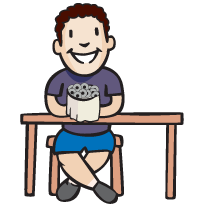Boston Children's Museum
308 Congress Street, Boston, MA 02210
617-426-6500
© Boston Children’s Museum 2025
Website Design by JackrabbitNow that you have tested one product…how about testing some more? Children are inundated with advertisements practically as soon as they are born. Many of these advertisements can be tricky…or even misleading. If we would like our children to grow up to be savvy consumers, we need to help them develop independent thinking skills, and have them practice being thoughtful about the choices that they make. This follow-up to the Consumer Reports Jr. activity encourages children to compare different brands of products, design scientific tests to compare those products, determine which of them is the best buy, and share the results with their peers, family and community.
This activity is a follow up to Consumer Reports Jr. In that activity, students tested different brands of facial tissue. In this activity, you and your students will determine which new product (or products) to test. Once you have chosen, you will need to purchase 3-4 different brands of that product and provide the tools necessary to test them. As a result, this activity takes place over several days and sessions.

Remind your students of the tests they conducted on facial tissues. Which brand was determined to be the best buy? Are there other products they think they can test? Have them brainstorm a list of products. Record the list. Past groups have tested a range of products, including:
Once you have the list, you should narrow it down to two or three products, and ask the group to vote on which one you’ll test together. If you have the resources, you can assure them that you will test others in the future. Select the product you’ll be testing based on the vote.
Can you find a new product to test, and determine which brand is the best buy?
SESSION 1
SESSION 2
After each team has designed their experiments and has begun testing, take a break and bring the group together to talk about what they have done so far. Have each team report about what they are testing and how they are conducting their test. As they describe their tests, ask them questions that help them think about how carefully they are testing. Ask them why it might be important that they test each brand exactly the same way they tested the others.
Have teams go back to their experiments to finish their testing. Stress the importance of recording their results. Once all tests are done and teams have their results, ask them to assign a score to each brand for each test. The top performer for each test gets a ‘1’, second place gets a ‘2’, third place gets a ‘3’ and 4th place gets a ‘4’. If any brands tie, teams should AVERAGE the two scores…for example, if two brands tie for the best results for number of kernels left unpopped, one of them would have gotten a 1 and the other a 2…averaging the two yields a 1.5, so they should each be scored with a 1.5. Tying for 1st = 1.5; tying for 2nd = 2.5; tying for last = 3.5. Ask each team to share their scores and record them on a chart (figure 1).
Notice that each of the team’s scores are recorded in the “Attribute 1” column, then the average is calculated. You can ask kids how to find the average of a group of numbers (add them together then divide by how many numbers there were), and maybe even ask them to determine the average themselves. In the chart above, Product ‘D’ is the winner (the lowest score), followed by ‘C’, then ‘A’ and then ‘B’ scored the worst. Do the same for each attribute. You can ask the teams to calculate the cost per cookie/kernel/bag of the 4 different brands, depending on the product you have tested, or you can simply write down the cost. Again, assign each brand a score from 1-4, with 1 being the lowest cost, 4 being the most expensive.
In the “Total” column, find an average for each brand’s score—add up the scores for each attribute (including cost) and divide by the number of attributes. The brand with the lowest average score is the winner!
Ask your kids to name all of the different brands they have heard of for the product you tested, and write them on a piece of chart paper as they list them. Tell your students which 3 or 4 brands you bought and ask them to guess which is which, based on their tests. Reveal the winning brand. Were they surprised by the results?
SESSION 3 AND BEYOND
Take this project even further by testing more products and asking your students to develop a mechanism for sharing their results with their peers, their families and even their community. A newsletter could be sent home to families; a blog or website could share the results with an even broader group. A family event in which students act out “commercials” for the tested products…there are many ways in which this useful information can be shared.